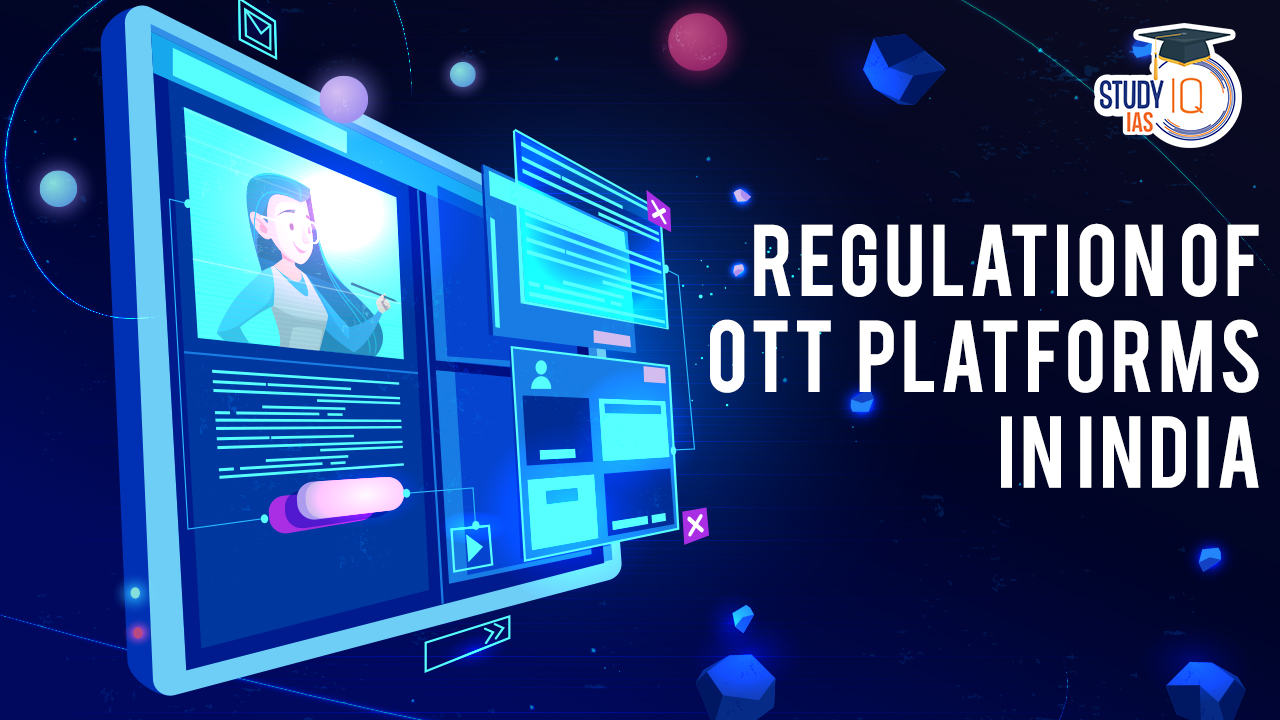Table of Contents
Context: The Telecom Regulatory Authority of India (TRAI) is likely to issue guidelines on whether OTT services should be regulated or be let to continue to operate as it is.
More on News
- The Telecom Regulatory Authority of India (TRAI) released a consultation paper seeking responses on a regulatory mechanism for OTT communication services.
- These communication services include WhatsApp, Signal, Meta, Google Meet, Zoom, and others, not content-based OTT platforms like Netflix and Amazon Prime.
- Content regulation falls under the Ministry of Information and Broadcasting (MIB), not TRAI.
- The selective banning of OTT services was prompted by a Parliamentary Standing Committee’s notice to the Department of Telecom (DoT) which was concerned about the unrest caused by these platforms, which have a broad reach and significant impact on society.
- Telecom Service Providers (TSPs) argue that OTTs should be regulated and charged because they utilize the infrastructure created by telecom operators without contributing financially. They claim that OTT communication services have led to a decline in their revenue streams.
- The demand from TSPs, represented by the Cellular Operators Association of India (COAI), is for a policy framework that ensures fair contributions from large OTT service providers to telecom network operators, based on criteria like the number of subscribers or data usage. They argue that these funds would support network expansion and contribute to government revenue.
- On the other hand, the Internet Service Providers Association of India suggests that if OTT services are substitutable services offered by licensed providers, they should be governed by the same rules as telecom services.
- However, organizations like the Internet and Mobile Association of India (IAMAI) oppose additional regulations and cost-sharing mechanisms, arguing that they would increase the cost of internet usage and go against the principles of net neutrality.
Understanding Over The Top (OTT) Platforms
- OTT or Over The Top Platforms are services that offer viewers access to movies, TV shows and other media directly through the Internet, bypassing cable or satellite systems.
- India’s OTT viewership stands at 43 million people and is projected to rise to 50 million by the end of 2023.
- In India’s regulatory parlance, OTT platforms are called ‘publishers of online curated content’.
- Online curated content is audio-visual content such as films, web-series, podcasts etc. made available to the viewers on demand, including but not limited through subscription by OTT platforms.
- “On demand” means a system where a user is enabled to access, at a time chosen by them, any content in electronic form, which is transmitted over a computer resource and is selected by the user.
- Popular video-on-demand services in India include Disney+ Hotstar, Amazon Prime Video, Sony LIV etc.
Current mechanism for OTT regulation in India
- Certain laws such as Information Technology Act 2000, Indian Penal Code 1861, and Indecent Representation of Women (Prohibition) Act 1986 have been made applicable to the content generated on OTT Platforms.
- New IT Rules 2021: Government has come up with Information Technology (Intermediary Guidelines and Digital Media Ethics Code) Rules 2021 under section 87 (2) of the Information Technology Act, 2000.
Its key provisions include:
- As per the rules, the Ministry of Information and Broadcasting (I&B) shall regulate content on OTT and online platforms.
- The Code of Ethics for online news, OTT platforms and digital media prescribe the guidelines to be followed by OTT platforms and online news and digital media entities.
- Self-Classification of Content: OTT platforms would self-classify the content into five age-based categories: U (Universal), U/A 7+, U/A 13+, U/A 16+, and A (Adult).
- Platforms would be required to implement parental locks for content classified as U/A 13+ or higher, and reliable age verification mechanisms for content classified as “A”.
- India’s approach to OTT regulation can be termed as a light-touch ‘coregulation’ model where there is ‘self-regulation’ at the industry level and final ‘oversight mechanism’ at the Ministry level.
- A three-level grievance redressal mechanism has been established under the rules with different levels of self-regulation:
- Grievance Redressal Officer: Publisher shall appoint a Grievance Redressal Officer based in India who shall be responsible for the redressal of grievances received by it.
- Self-Regulatory Body: There may be one or more self-regulatory bodies of publishers. Such a body shall be headed by a retired judge of the Supreme Court, a High Court or independent eminent person and have not more than six members.
- Oversight Mechanism: Ministry of Information and Broadcasting shall formulate an oversight mechanism. It shall establish an Inter-Departmental Committee for hearing grievances.
- Also, Centre looks to regulate the content on digital platforms under the proposed Digital India bill.
Challenges with OTT Regulations
- Freedom of Expression: Excessive and strict regulation can inhibit creative freedom and curtail the scope of artistic expression.
- Low Compliance: The Rules mandate the display of contact details relating to grievance redressal mechanisms and grievance officers on OTT websites/interface. However, compliance is very low.
- While the Rules require disclosure of grievance details by publishers and self-regulating bodies, the reporting formats only capture the number of complaints received and decided.
- Jurisdictional issues: Many OTT platforms are based outside India, which makes it difficult to enforce regulations and hold them accountable.
- Ambiguity around content regulation and huge volume: Due to the vastness of online space, the volume of data created is huge and is generated rapidly which remains a concern.
- Privacy Concerns: It is difficult to strike a balance between the need for data and data privacy.
Way Forward
1. Establish a National Broadcasting Policy: A national broadcasting policy is essential due to the diverse mechanisms, regulations, and pricing structures employed by various broadcasters, including media broadcasters and OTT platforms.
2. Recognize the Distinction between Online and Conventional Content: Acknowledge the fundamental differences between web-based content and traditional media, with web content typically being more liberal and exploring unconventional themes.
This recognition should lead to a departure from conventional censorship paradigms, fostering innovation and creativity in the digital space.
3. Promote Awareness of Regulatory Provisions: Mandate OTT industry associations to conduct periodic awareness campaigns through print and electronic media to inform the public about the grievance redressal mechanism.
4. Implement Regular Auditing: Consider the establishment of an independent body responsible for conducting periodic audits. These audits should assess the effectiveness of access controls, age verification mechanisms, and the visibility of grievance redressal details on each OTT platform.
5. Engage Stakeholders for Effective Regulation: To address potential bottlenecks, implementation challenges, and prevent potential misuse of regulations, policymakers and stakeholders should maintain ongoing communication and collaboration. This collaborative approach will help create a regulatory framework that is both effective and balanced.


 Bhakti Movement in Punjab
Bhakti Movement in Punjab
 Sufi Movement in Punjab
Sufi Movement in Punjab
 Credit Guarantee Scheme for MSME’s
Credit Guarantee Scheme for MSME’s


















